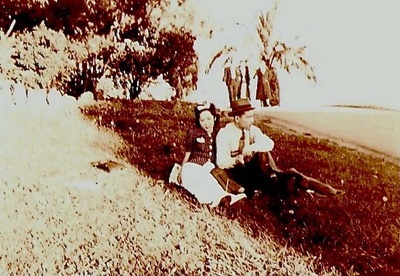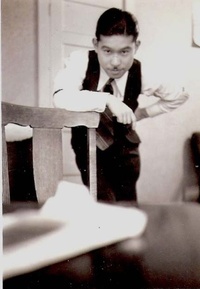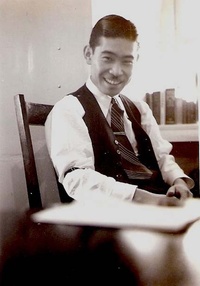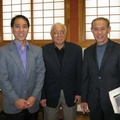Every young generation creates their own halcyon days; my parents’ generation was no exception. They came of age during the 1930s and ‘40s in San Francisco’s Nihonmachi. They met outside at a car garage in Japan Town in 1938, married by eloping to Reno in 1940, and moved briefly to the Salinas Assembly Center (a.k.a. Salinas Rodeo Grounds) after the beginning of WWII in 1942 (where this story ends).
This California Japantown story is primarily about my father, Roy Ishikawa and his return to the U.S. in 1933, more precisely to San Francisco’s “Nihonmachi” after growing up in rural Western Japan. The story of my mother, Edna Sakoda Ishikawa, is told from her recollection of how she met my father until their decision to leave San Francisco and the forced incarceration in America’s Assembly Centers in 1942 and subsequently America’s Concentration Camps during WWII.
My father, Roy Ishikawa is a Kibei (an American born Japanese who is raised in Japan and returns to live in the U.S.) born in 1915 on Rindge Tract, located in the Sacramento Delta near Stockton.
He and his entire family moved to Yanai-shi, Yamaguchi-ken, Japan in 1917. My paternal grandfather, Shinju Ishikawa was a contract and later cash-leasing farmer in Eastern Washington, Eastern Oregon, Idaho and Northern California. He sold to markets produce and grain crops (e.g., potatoes, onions, and rice).
He married by proxy to Sato Ihara in 1911 and together they reared 3-children in California (the first two born on Victoria Island and my dad on Rindge Tract), and five younger sisters subsequently born in Japan. Dad was educated in Japan and graduated from Yanai Commerce High School. In 1933, he returned to the U.S. and settled in San Francisco’s Japan Town.
1. Where did you live in San Francisco?
In San Francisco my dad lived in several locations, first briefly with a “hakujin” white American family working as a “school boy,” then at the YMCA located at 1409 Sutter St. and later at the Kashu Hotel, a residential hotel located on Laguna and Sutter Streets in Japan Town during the 1930s and until his and Edna’s incarceration during WWII.
One of his first memories upon his return to the U.S. in 1933 was his re-entry immigration at Angel Island and sleeping overnight on a metal frame bed with no mattress, just a blanket before being released to San Francisco.
I wonder if he was issued a pillow or was the shock of the bed too much to fog his memory? Welcome back to America! This welcoming happened after an arduous 10-day boat trip originating from Yokohama, Japan. He counted himself as fortunate compared to the hundreds of thousands of mainly Asian and Pacific Islander people who were processed at Angel Island from 1910 to its closing in 1940.
Although he remembers both the Golden Gate and Bay bridges under construction, as a person with little means and who did not own a car, he rode the passenger ferryboats that plied the bay to either Alameda or Tiburon. Those years provided many fond memories of enjoying picnics at Mt. Tamalpais in Marin County with his friends.
While living at the YMCA, the assistant director Tomizawa sensei, an issei (1st generation) had strongly encouraged the kibei to register to vote once they turned 21. The reason? To give the Japanese Americans a voice in America’s democracy, the issei could not vote due to lack of citizenship.
Japanese were unable to qualify for U.S. citizenship due to anti-immigration laws, directed at non-white and non-black people. Tomizawa sensei desired to empower the Japanese community in the U.S. As for my dad, he voted in his first U.S. Presidential election in 1940. He also recalled that one didn’t have to practice “Christianity” to live at the YMCA, though proselytizing was abundant.
2. Depression Food/Meals
Another early American memory was when he worked for a white American family in San Francisco and the lady of the house told him to make a turkey sandwich after Thanksgiving. He slathered cranberry sauce like it was jam and strongly disliked the tart taste and for years afterwards avoided eating cranberry sauce at Thanksgiving. This year’s Thanksgiving he couldn’t eat enough cranberry-plum sauce that I made. Good to know that he was not put off eating cranberry sauce for life.
Dad’s diet changed during the depression. He was so poor that he remembers eating Thompson seedless grapes and day old loaf of bread. A day old loaf cost 4¢, while fresh bread cost 5¢. He couldn’t remember how much the grapes cost.
Living in a residential hotel restricted cooking and thus meals were either cold, made on the sly (using a hotplate), or eaten at a nearby cafeteria. Later, when he and his new bride married, they continued to live at the Kashu Hotel and ate their meals at a nearby cafeteria. The kind owner/cashier knew of their new marriage and their financial condition, similar to many others, and my mom ate for half-off the regular price. Of course through the years, dad remembers the nice lady’s smile accorded to him and his bride.
3. What kind of work did you do?
My father worked many jobs just to survive the Great Depression. He was employed as a “school boy,” he sold newspapers for the Call-Bolton for 3¢ a copy and was able to keep 1¢ of the sales per paper. Being newly arrived, his American accent was not perfected and it never would be, and he practiced yelling “Call-Bolton, Call-Bolton” over and over in an alley till his voice sounded hoarse just so that others may understand his heavy accent.
He delivered dry-cleaning for a Japanese-owned cleaners located on 19th St. He also worked in a garage where one day his future wife walked by with a couple of girlfriends and upon their first chance meeting, he presented her with a white gardenia. My dad used to buy fragrant flowers regularly in those days, no doubt to cheer up his dreary living environment. I wonder why he had not selected either of the other two girls to present his cherished flower? He later learned a trade and attended bartender’s school and before he could even graduate, he was offered a job at the Ginza Restaurant and Bar located on the corner of Post and Buchanan streets.
One of the funnier stories recounted was how he and other kibei would work to survive. One friend would find a job and not possessing any qualifications would work 1-day and then send his other friend to the job and he would get a chance to work, and possibly another friend would rotate. This way everyone gained a chance to work and was able to eat.
The depression taught these young men how to become savvy, thoughtful, and resourceful to survive. Dad remembers sharing a room with three other kibeis, three sleeping in a double bed and one sleeping next to the fireplace on the ground. I wonder if the guy sleeping solo on the ground was the fortunate one? My father was usually stuck sleeping in the middle of the bed and learned to sleep without moving, similar to a mummy. He still prides himself about this trait.
© 2011 Troy Ishikawa








